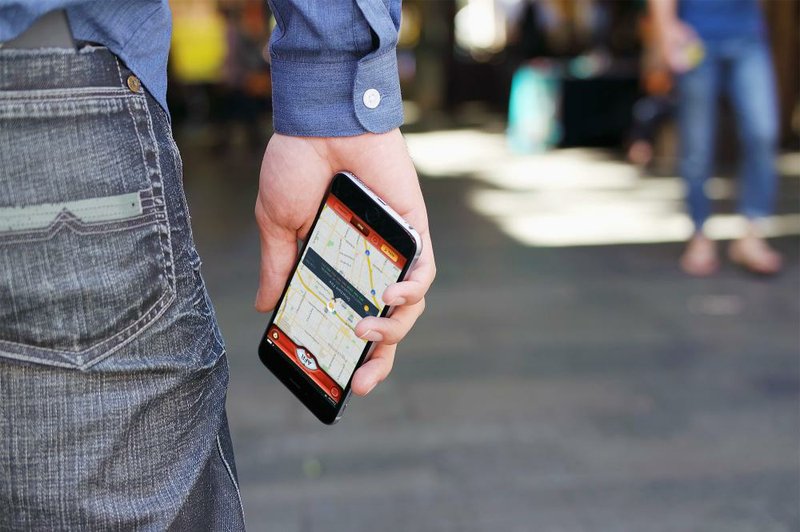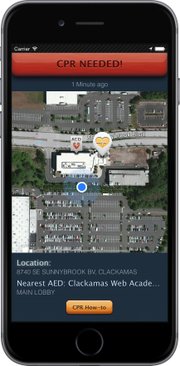When 911 dispatchers get a call that someone has collapsed and stopped breathing, they quickly notify first responders. In Rogers and hundreds of communities across the country, they also notify nearby citizens, via smartphone.
Rogers Fire Department uses the mobile app PulsePoint, which sends push notifications to would-be Samaritans within a half-mile of any report of possible cardiac arrest in a public place.
The idea is that they could reach the stricken person and start cardiopulmonary resuscitation (CPR) while professionals are still rushing to the scene. The app also highlights the nearest publicly accessible automated external defibrillator (AED).
"This has been a wonderful app," Rogers Fire Chief Thomas Jenkins says.
Since he announced the program in July, about 1,100 Rogers residents have downloaded the free PulsePoint app. It has summoned citizens four times since October. In no case had the victim actually suffered cardiac arrest, so none of the app users performed CPR.
But they showed up, Jenkins said. "What it has shown is that it works."
The $45,000 expense to the city to acquire PulsePoint, tie it into the dispatch system and maintain it, would be worthwhile if it saved one life -- which he is sure it will in time. But the app has broader features, too.
The app lets users subscribe to instant notifications about other kinds of emergencies, from structure fires to car crashes. "If
you want to be, you can be notified of those emergencies instantaneously, just as the firefighters are being notified of the emergency themselves," he said.
Users who don't want to receive alerts "can go to the app and just see what we've done for the last 12 hours," Jenkins said. "On the app itself, you can listen to our radio traffic.
"It's almost like having a little scanner."
It updates in real time with the status of various fire units that answer a call. That tool helps him do his job.
"It's the best way to know what's going on in the city of Rogers," he said.
Improved public awareness of the department's activity "wasn't the primary purpose of getting the app," he added, "but it's an important secondary benefit that our community can see with a lot of transparency what its tax dollars are doing."
In addition, the system works with a PulsePoint AED database app for professionals. "Matter of fact, we use it as our sole AED registry now," Jenkins said.
IN THE FIELD
The PulsePoint app was the brainchild of Richard Price, former fire chief of the San Ramon Valley Fire Protection District in California. It was developed through collaboration between the district and Northern Kentucky University to assist people who experience cardiac arrest.
During cardiac arrest, the heart suddenly stops beating, and the victim loses consciousness. If not treated within minutes, it usually results in death, according to the National Institutes of Health.
Sudden cardiac arrest differs from a heart attack, in which blood flow is blocked but the heart usually doesn't stop beating and the person remains conscious.
Every year, more than 326,000 people experience cardiac arrest somewhere other than in a hospital, according to the American Heart Association. Ninety percent of them die. But if effective CPR is administered within three to five minutes, it can double or triple a victim's chance of survival.
Every minute that ticks by lessens the victim's odds of revival by about 10 percent, Jenkins said. And so the potential for a bystander to help save a life using CPR is real, even though CPR "by itself is rarely if ever going to get somebody back from the brink of death."
"CPR is merely a time-saving tool that continues to perfuse the heart with some limitedly oxygenated blood," Jenkins said. "But it buys us some time to get there and to defibrillate the heart or to administer the drugs to the patient that fix an arrhythmia."
The heart association recommends that bystanders provide hands-only CPR -- which involves chest compressions but not mouth-to-mouth breathing -- if they see a teen or adult collapse suddenly. The group says that any attempt is better than none until emergency workers arrive.
PulsePoint was released in 2010, and the number of cities that are connected has grown to nearly 1,200 in 22 states, according to Shannon Smith, spokesman for the nonprofit PulsePoint Foundation.
FILLING A NEED
PulsePoint is one of a number of apps being used nationwide to improve expert response to health emergencies.
A software developer in Falls Church, Va., for example, created the free 911HelpSMS app, which informs a user of where he is located before he calls 911 in a medical emergency. Cellphone towers aren't always able to pick up a caller's location on a 911 call.
It is especially useful if the person has been in an accident or is unable to speak or is in an unfamiliar place. He taps once to load the app, then a map appears that shows his location on the screen along with a red button to call 911. The app also instantly texts multiple family members and gives them the person's GPS location.
Another free app, EMNet findER, was developed by Massachusetts General Hospital. It allows users -- including people who have suddenly become sick and emergency medical technicians -- to find the nearest hospital.
GENERAL EMERGENCY
Unlike PulsePoint, most other apps related to health emergencies don't target just one type of medical crisis.
The ICEBlueButton app, which is free, lets people use their smartphone to store information that might be helpful if they have any type of medical emergency. That can include their doctor's name, emergency contacts, allergies, medications and medical conditions. Emergency responders can access this information by scanning a bar code on the lock screen of the patient's phone.
Another app, Twiage, allows first responders to send patient information from the ambulance to the hospital, including photos, videos and EKG results. The information appears on a computer screen at the emergency room, along with the patient's estimated time of arrival.
The app is free for emergency responders. Hospitals that get the data pay a subscription fee, said YiDing Yu, a physician who co-founded Twiage.
Yu said that across the country, ambulances still use radios and phone calls to alert hospitals, a process that can lead to errors and delays in treatment. The app was created to help hospitals accelerate care for patients who have had strokes, heart attacks or major trauma.
Lori Moore-Merrell heads the research division of the International Association of Fire Fighters, which represents about 300,000 professionals. "If these apps can get a bystander to engage in CPR or help us get there faster or better communicate with the hospital prior to arrival, we're absolutely supportive of that," she said.
But she added, "With any technology, we can't be so dependent on it that if it goes down, we're in trouble. We always need to be prepared to do what we do without technology."
Celia Storey added information to this report, which was produced by Satellite, an initiative of the Pew Charitable Trusts.
ActiveStyle on 05/25/2015

